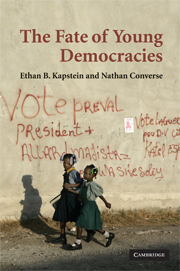Book contents
- Frontmatter
- Contents
- List of Figures and Tables
- Preface and Acknowledgments
- 1 What Makes Young Democracies Different?
- 2 Why Do Young Democracies Fail?
- 3 Are Some Regions More Democracy Friendly?
- 4 Is Democracy Promotion Effective?
- 5 Conclusions and Policy Recommendations
- Appendix 1 Methodology
- Appendix 2 List of Young Democracies
- References
- Index
Appendix 1 - Methodology
Published online by Cambridge University Press: 05 June 2012
- Frontmatter
- Contents
- List of Figures and Tables
- Preface and Acknowledgments
- 1 What Makes Young Democracies Different?
- 2 Why Do Young Democracies Fail?
- 3 Are Some Regions More Democracy Friendly?
- 4 Is Democracy Promotion Effective?
- 5 Conclusions and Policy Recommendations
- Appendix 1 Methodology
- Appendix 2 List of Young Democracies
- References
- Index
Summary
Definition of Democracy
Classifying governments as democratic or nondemocratic, as well as identifying episodes of political change as democratizations, is fraught with theoretical and practical pitfalls. For example, Milanovic (2005) finds that when using the Polity IV index of democracy, which has a 20-point scale (−10 to +10) that ranks regimes from most authoritarian to most democratic, where the analyst draws the line (e.g., at 0 or at +1) between democracy and authoritarianism has a significant impact on the findings. Our analysis attempts to avoid engaging with this particular issue by first identifying democratizations and then classifying the regime prior to the democratization as undemocratic and the resulting regime as a new democracy. Consequently, a more accurate term for the countries that we analyze might be “newly democratized” countries rather than democracies.
In building our democratization data set, we have relied on the Polity IV data set on political regime characteristics and transitions (Marshall and Jaggers 2005). Although the aggregation of the various components of the Polity score has been characterized as problematic (Munck and Verkuilen 2002), the extensive disaggregated data on regime characteristics that the Polity project makes available led us to use this measure. In particular, we employ the Polity IV score for the level of constraints on the executive, a factor not assessed by, for example, the classification developed by Przeworski et al. (2000). Consequently, we found the Polity data the most appropriate for our purposes.
- Type
- Chapter
- Information
- The Fate of Young Democracies , pp. 157 - 162Publisher: Cambridge University PressPrint publication year: 2008

